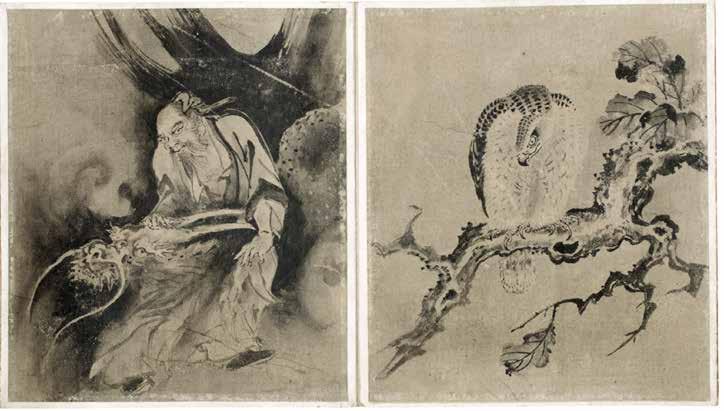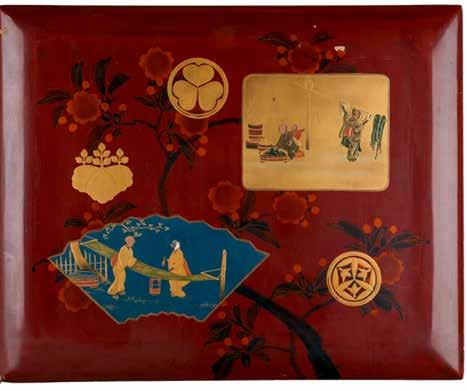
9 minute read
Painting power and prestige: the shogun, daimyo and the Kanō school
Russell Kelty
For more than 400 years, the Kanō school of painters, based in Kyoto and Edo (Tokyo), created a definitive style of painting and a common visual language, which still resonates today. The remarkable longevity of the school ‘was the product of resourceful adaption to an ever changing landscape of patrons and prospects’. 1 The school’s origin in the fifteenth century during the failing Ashikaga shogunate and subsequent commissions from prominent daimyo and temples in Kyoto allowed the establishment of numerous branches throughout the archipelago. The Kanō school flourished into the nineteenth century and remains the longest running and most influential hereditary assemblage of professional painters in Japan and is unique in world art history.
Advertisement
Catering to the military elite, the Kanō painters used a combination of Chinese themes, bold brush-and-ink strokes, lush pigments and cut gold. This innovative style was intended to illuminate and embellish works initially intended to decorate temples and large castle interiors, with the aim of conveying a sense of grandeur and opulence. The artists of the Kanō school were not simply great painters but also connoisseurs who established collections from which to draw inspiration.
Birds, tree and flowers is signed by the artist Kanō Sanraku (1559–1635) (fig. 1), a master screen painter who was an adopted fifth-generation Kanō school artist and founder of the Kyoto branch. It displays the graceful and refined flowing style that set him apart from his contemporaries.
Painted late in Kanō Sanraku’s life, between 1624 and 1635, this sixpanel screen was most likely one of a pair and depicts the birds and flowers associated with late winter and early spring amid an expanse of cut gold leaf. On the left, an ancient willow tree extends its branches over a bamboo fence, while flowering camellias and young bamboo shoots, symbolising renewal and regeneration, indicate that spring is near. A white heron takes flight, while another rests on the tree – a staple motif in Japanese poetry and art, as herons evoke elegance and are often associated with winter. The extravagance of the cut gold contrasts with the dark blue stream, in which a solitary duck swims. The rock is a reminder that Chinese philosophical and cultural elements such as Daoism and brushand-ink painting had a profound impact on this school.
1 Yukio Lippit, ‘The Kanō school: the first hundred years’, in Felice Fischer & Kyoko Kinoshita, Ink and gold: art of the Kanō, Yale University Press, New Haven, 2015, p. 1.
fig. 1: Kanō Sanraku, born Shiga prefecture, Japan 1559, died Kyoto, Japan 1635, Birds, tree and flowers, 1624–35, Kyoto, six-panel screen, ink, colour and gold on paper, 173.0 x 370.0 cm; Gift of Andrew and Hiroko Gwinnett through the Art Gallery of South Australia Foundation 2015. Donated through the Australian Government’s Cultural Gifts Program
The signature on the lower left side displays the characters for his name (Kanō Sanraku hitsu), meaning ‘the brush of Kanō Sanraku’, with two seals that are consistent with screens from the period, after 1619.
Dragon and bamboo (fig. 2) was created by the foremost painter of the period, Kanō Tan’yu (1602–1674), who was appointed as the official artist for the Tokugawa shogunate in 1615. In this dynamic performance of brushwork, Tan’yu captures the moment the head and claw of a dragon emerge from the whorls of rain-laden clouds. The ‘wetness’ of the moment is emphasised by the use of a watery ink and controlled splashes. The poem below captures the majesty of the dragon and its connections to the natural world:
rising out of the clouds, dragons run and fly on the ground, mountains and rivers.
The hanging scroll was created in c.1625, not long after Tan’yu’s relocation from Kyoto to Edo, and its significant size indicates that it was intended for a patron of importance and stature. Dragons remain a prominent symbol of enlightenment, and Kanō Tan’yu was aware of the spectacular paintings of them at the Zen temples throughout Kyoto that had been created by the founders of the Kanō school.
According to ancient accounts, dragons are composed of a fantastic collection of beastly parts, such as the horns of a stag, the belly of a sea monster and the claws of an eagle. As a result, the dragon was considered to be the king of animals and was associated with the elite and powerful, such as the Emperor. The symbolic potency of dragons was heightened by the fact that they appeared at will in the sky, accompanied by dynamic meteorological events such as rain, lightning and tornadoes, the latter still referred to as a ‘dragon’s whirlwind’. For Daoists, the dragon and tiger symbolise the dynamic balance of the forces of yin and yang, which foster harmony in the cosmos. The presence of a tiger is indicated in the painting by the trunk and leaves of a solitary bamboo, which is depicted on the left.

fig. 2, left: Kanō Tan’yu, born Kyoto 1602, died Edo (Tokyo) 1674, Dragon and bamboo, with inscription after Sesshū Tōyō (1420–1506), c.1625, hanging scroll, ink on paper (overall), 94.0 x 50.5 cm (image); box: 9.0 x 8.0 x 75.0 cm; Gift of Shane Le Plastrier through the Art Gallery of South Australia Foundation 2017
fig. 3, right: Kanō Tan’yu, born Kyoto 1602, died Edo (Tokyo) 1674, Daigu Sōchiku, born Mino province, Japan 1584, died Japan 1669, Hotei, c.1625, hanging scroll, ink on paper, 172.5 x 28.5 cm (image); Gift of Shane Le Plastrier through the Art Gallery of South Australia Foundation 2017
As an artist trained in the longest surviving and most influential school of painting in Japan, Kanō Tan’yu had an acute understanding of his artistic lineage, as well as of the history of art. Dragon and bamboo includes an intriguing inscription, dating the painting to the ‘second year of Bunmei [1468], fourth month, fifth day; poem and painting by the pen of an eighty-year-old’. This seems to be a homage to the great Japanese master of brush and ink, Sesshū Tōyō (1420–1506), and identifies Kanō Tan’yu as an avid collector and historian of Chinese and Japanese brush and ink.
As a well-known painter of the period, Kanō Tan’yu often created paintings collaboratively with prominent Zen Buddhist monks, whose own painting and calligraphy were highly sought after. The hanging scroll, Hotei, created c.1625 by Kanō Tan’yu and the Zen Buddhist monk, Daigu Sōchiku (1584–1669) (fig. 3), depicts one of the most loved and revered characters in Zen Buddhism. The word hotei translates as ‘cloth sack’, shown here as the cheerful, pot-bellied monk with a shaven head, Hotei, who is said to have roamed the countryside in Southern China. In Japan, Hotei is revered as one of the seven gods of good fortune and is often associated with new year’s rituals. Kanō Tan’yu has deftly used a diversity of brushstrokes and ink colours to portray Hotei’s dense sleeves, rigid walking stick and the soft contours of his bag and unshaven face. Above the image is a koan or riddle, given to students as a way to empty their minds of rational thought and which can produce a moment of profound insight into the nature of existence. It reads from top to bottom, right to left:
Monk Genyo: ‘Now I have nothing’ Priest Choshu roared: ‘Throw it away’ Genyo said: ‘I have nothing, what can I throw away’? Choshu said: ‘Then you have to carry it’.
The humorous contrast between the much-loved Hotei, who is inextricably linked to his bag, and the koan, which advocates the discarding of both physical and mental baggage, would have been obvious to those viewing the scroll.
As connoisseurs, members of the Kanō school held repositories of the works of well-known Chinese and Japanese brush-and-ink painters. At times they compiled or rehoused images they felt were worthy of significant status. Identifying the unsigned works of prominent artists elevated their status as connoisseurs and, similar to the tradition of impressing a collector’s seal on a scroll, they provided a statement to that fact. The album, Collection of paintings by Sesson (Sesson gajō) (fig. 4), includes twenty-two brush-and-ink paintings attributed to the artist Sesson Shūkei, whose work is often described as singular, unique, individual and eccentric. This rare collection includes two inscriptions by Kanō school artists, signifying that it was once a revered heirloom.
Sesson Shūkei (c.1492–1589) is considered the last great brush-andink painter of the Muromachi period (1392–1573), although his life is shrouded in mystery as a result of his constant travel to study collections of Chinese and Japanese paintings in Zen temples in the Kantō region (near present-day Tokyo).
Born into the Satake military family in northern Japan, Sesson entered a Buddhist Zen temple to train as a painter at an early age and in 1546 travelled to present-day Fukushima prefecture to teach ‘painting connoisseurship’ to an unknown daimyo. During a period of considerable turmoil and shifting military alliances, Sesson’s ability to maintain independence and convivial relationships with patrons is possibly the reason for his particular painting style. In his seventies Sesson settled in the province of Iwaki (present-day Fukushima prefecture).
Collection of paintings displays a diverse selection of themes and techniques, these reflecting the Zen Buddhist aesthetic of the period and now considered ‘classic’. Sesson’s depictions of flora and fauna show a subtle elegance, which contrasts with the power evoked in the portraits of Daoist and Buddhist patriarchs also in the album, although his novel interpretations of Chinese landscape painting, which are easily identified by their splashed ink and lack of depth, are particularly striking. Sesson’s landscapes show similarities to those of artists such as Tenshō Shūbun (1414–1463) and Sesshū Tōyō (1420–1506), with Sesson deriving his name from the latter. The entire album is a tribute to Sesson’s enduring influence on generations of artists in Japan, who used his life and pursuit of individual perfection as a model for seeking their own particular aesthetic.
While Sesson did not sign his works until later in his life, the album includes inscriptions by the well-known Kanō school painters, Kanō Tsunenobu (1613–1713) and Kanō Isen’in Naganobu (1775–1828), on the first and last pages; in these inscriptions Sesson is identified as the artist of the collection.
Possibly compiled in the seventeenth or eighteenth century, the album is assumed to have been an heirloom – the luxurious textiles on the front of the album are an indication of its high status – which artists of the Kanō school consulted on auspicious occasions for inspiration or simply to admire a master painter.
fig. 4, details: Sesson Shūkei, born Hitachi province, Japan c.1492, died Fukushima prefecture, Japan 1589, Collection of paintings by Sesson (sesson gajō), compiled 18th century, ink, gold on paper; silk, metallic thread, natural and resist dyes and supplementary-weft brocade, twenty-two paintings, 26.5 x 23.5 x 2.5 cm; Gift of Raphy Star through the Art Gallery of South Australia Foundation 2017. Donated through the Australian Government’s Cultural Gifts Program












